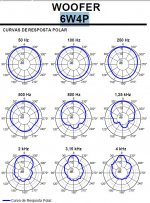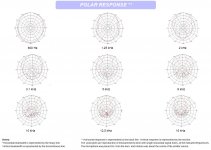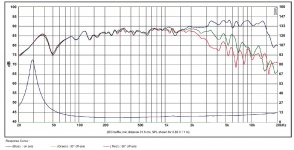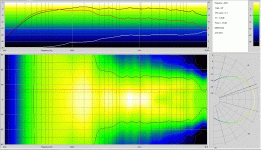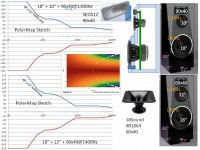I have considered using the HM100Z0 or HM130C0 in an array of four to match the TPL-150H's directivity.
Another possibility is to use an array of two BG Neo10 planars, to also match the directivity of the TPL. The Neo10 is said to sound 'fast' and most who have used it, claim it to be one of the best midranges ever. My favourite option ATM.
Another possibility is to use an array of two BG Neo10 planars, to also match the directivity of the TPL. The Neo10 is said to sound 'fast' and most who have used it, claim it to be one of the best midranges ever. My favourite option ATM.
Another possibility is to use an array of two BG Neo10 planars, to also match the directivity of the TPL. The Neo10 is said to sound 'fast' and most who have used it, claim it to be one of the best midranges ever. My favourite option ATM.
We tried out two Neo10 side-by-side with the TPL-150 as well as compared them to the 12P80Nd here:
http://www.diyaudio.com/forums/plan...o-neo10-side-side-encosure-2.html#post3910828
I don't own the TPL-150 yet, so not tried it together. But I own Satori, it is very clean, low distortion, very realistic tone, flat FR. It's slightly warmish compared to metal, but not audible as warmth, just a gentler 'music lover' feeling, instead of audiophile 'showoff' feeling. It's too small for bass duty but 200Hz up it's near perfect. Dynamics and transient response is excellent for midrange duty. No breakup, flat FR and low inductance so crossover can go any freq. With a contour filter it is even OK as full range. Good value considering the performance.
The drawback is it's a hifi driver, so it has low sensitivity, nominal 87.5dB. Parallel makes 93dB, but that's still a -6dB pad on the TPL-150 which will kill off some dynamics.
The drawback is it's a hifi driver, so it has low sensitivity, nominal 87.5dB. Parallel makes 93dB, but that's still a -6dB pad on the TPL-150 which will kill off some dynamics.
Owners of Beyma TPL-150 tweeters who post their experiences and test results generally support a crossover frequency of 1600Hz or higher with a 3rd-4th order acoustic slope. There is a difference between measuring a flat frequency response down to 1200Hz, and critical listening that detects problems with dynamics and intermodulation distortion when the Xover is under 1600Hz.
Both the midbass and the TPL-150xx must have the same polar response at the crossover frequency for a smooth controlled directivity function.
A TPL-150 without any horn has a 180degree polar resonse at 1600Hz on a wide flat baffle. Several midbass up to 6"-6.5" polar data show a 180degree polar response up to 1600Hz on a wide flat baffle. The Satori midbass has great reviews, but just reaches 1600Hz and is only 87db sensitivity.
A TPL-150H with the factory horn has a 80x40 degree polar resonse at 1600Hz on a wide flat baffle. A few midbass around 8"-10" have a 80degree polar response at 1600Hz on a wide flat baffle. The Lambda TD10M, and the Tang Band W8-1808 with the whizzer removed are mentioned.
A TPL-150H with a custom horn can provide a 60x40 degree polar resonse at 1600Hz on a wide flat baffle. A few midbass around 12" have a 60 degree polar response at 1600Hz on a wide flat baffle. Cone beakup is a big concern. 18 Sound 12" 12NMB420 with a 33g Mms is also worth consideration with the Beyma 12P80Nd and Lambda TD12M.
Both the midbass and the TPL-150xx must have the same polar response at the crossover frequency for a smooth controlled directivity function.
A TPL-150 without any horn has a 180degree polar resonse at 1600Hz on a wide flat baffle. Several midbass up to 6"-6.5" polar data show a 180degree polar response up to 1600Hz on a wide flat baffle. The Satori midbass has great reviews, but just reaches 1600Hz and is only 87db sensitivity.
A TPL-150H with the factory horn has a 80x40 degree polar resonse at 1600Hz on a wide flat baffle. A few midbass around 8"-10" have a 80degree polar response at 1600Hz on a wide flat baffle. The Lambda TD10M, and the Tang Band W8-1808 with the whizzer removed are mentioned.
A TPL-150H with a custom horn can provide a 60x40 degree polar resonse at 1600Hz on a wide flat baffle. A few midbass around 12" have a 60 degree polar response at 1600Hz on a wide flat baffle. Cone beakup is a big concern. 18 Sound 12" 12NMB420 with a 33g Mms is also worth consideration with the Beyma 12P80Nd and Lambda TD12M.
A TPL-150 without any horn has a 180degree polar resonse at 1600Hz on a wide flat baffle. Several midbass up to 6"-6.5" polar data show a 180degree polar response up to 1600Hz on a wide flat baffle. The Satori midbass has great reviews, but just reaches 1600Hz and is only 87db sensitivity.
Do you mean to say that the Satori polar response is 180deg only up to 1600Hz? That's true of any 6" driver. Just to clarify, Satori useable bandwidth extends above 1600Hz. Are you suggesting an even smaller mid driver to preserve power response on flat baffle? Thanks
Richidoo, I was sloppy in my earlier post and used 180degree to describe the idea of a wide polar pattern, where >120degree polar response would be a more accurate description of the physical limits of the AMT width and the speaker cone diameter. A 5" moving diameter cone polar response would first start to narrow at 1/4 wavelenth(680Hz), with a >120degree polar response at 1/2 wavelength(1360Hz).
For a 1600Hz Xover, a 6" - 6.5" midrange with a clever cone profile like the Satori is probably the largest diameter usable with the TPL-150 for smooth controlled directivity polar response with a >120degree wide M-T transistion polar response. Most larger diameter speakers would likely benefit from a TPL-150(HORN of some type).
======
Owners of Beyma TPL-150 tweeters who post their experiences and test results generally support a crossover frequency of 1600Hz or higher with a 3rd-4th order acoustic slope. There is a difference between measuring a flat frequency response down to 1200Hz, and critical listening that detects problems with dynamics and intermodulation distortion when the Xover is under 1600Hz.
Both the midbass and the TPL-150xx must have the same polar response at the crossover frequency for a smooth controlled directivity function.
A TPL-150 without any horn has a wide(>120 degree) polar resonse at 1600Hz on a wide flat baffle. Several midbass up to 6"-6.5" polar data show a wide(>120 degree) polar response up to 1600Hz on a wide flat baffle. The Satori midbass just maintains wide-polar as it reaches 1600Hz , and is only 87db sensitivity.
A TPL-150H with the factory horn has a 80x40 degree polar resonse at 1600Hz on a wide flat baffle (attached). A few midbass around 8"-10" have a 80degree polar response at 1600Hz on a wide flat baffle. The Lambda TD10M, and the Tang Band W8-1808 with the whizzer removed are mentioned.
A TPL-150H with a custom horn can provide a 60x40 degree polar resonse at 1600Hz on a wide flat baffle. A few midbass around 12" have a 60 degree polar response at 1600Hz on a wide flat baffle. Cone beakup is a big concern. 18 Sound 12" 12NMB420 with a 33g Mms is also worth consideration with the Beyma 12P80Nd and Lambda TD12M.
For a 1600Hz Xover, a 6" - 6.5" midrange with a clever cone profile like the Satori is probably the largest diameter usable with the TPL-150 for smooth controlled directivity polar response with a >120degree wide M-T transistion polar response. Most larger diameter speakers would likely benefit from a TPL-150(HORN of some type).
======
Owners of Beyma TPL-150 tweeters who post their experiences and test results generally support a crossover frequency of 1600Hz or higher with a 3rd-4th order acoustic slope. There is a difference between measuring a flat frequency response down to 1200Hz, and critical listening that detects problems with dynamics and intermodulation distortion when the Xover is under 1600Hz.
Both the midbass and the TPL-150xx must have the same polar response at the crossover frequency for a smooth controlled directivity function.
A TPL-150 without any horn has a wide(>120 degree) polar resonse at 1600Hz on a wide flat baffle. Several midbass up to 6"-6.5" polar data show a wide(>120 degree) polar response up to 1600Hz on a wide flat baffle. The Satori midbass just maintains wide-polar as it reaches 1600Hz , and is only 87db sensitivity.
A TPL-150H with the factory horn has a 80x40 degree polar resonse at 1600Hz on a wide flat baffle (attached). A few midbass around 8"-10" have a 80degree polar response at 1600Hz on a wide flat baffle. The Lambda TD10M, and the Tang Band W8-1808 with the whizzer removed are mentioned.
A TPL-150H with a custom horn can provide a 60x40 degree polar resonse at 1600Hz on a wide flat baffle. A few midbass around 12" have a 60 degree polar response at 1600Hz on a wide flat baffle. Cone beakup is a big concern. 18 Sound 12" 12NMB420 with a 33g Mms is also worth consideration with the Beyma 12P80Nd and Lambda TD12M.
Attachments
I don't own the TPL-150 yet, so not tried it together. But I own Satori, it is very clean, low distortion, very realistic tone, flat FR. It's slightly warmish compared to metal, but not audible as warmth, just a gentler 'music lover' feeling, instead of audiophile 'showoff' feeling. It's too small for bass duty but 200Hz up it's near perfect. Dynamics and transient response is excellent for midrange duty. No breakup, flat FR and low inductance so crossover can go any freq. With a contour filter it is even OK as full range. Good value considering the performance.
The drawback is it's a hifi driver, so it has low sensitivity, nominal 87.5dB. Parallel makes 93dB, but that's still a -6dB pad on the TPL-150 which will kill off some dynamics.
Are you referring to the SB65WBAC25-4, which is their two & a half inch driver? How many of these drivers are you using per channel to get their sensitivity raised from 87.5dB to 93dB? Also what are you paying per driver?
I'm listening to Make Someone Happy by Sophie Milman
Thanks,
Thetubeguy1954 (Tom Scata)
Last edited:
The B&C 6md38 has a curvilinear cone and doesn't narrow until about 2khz on a 12" baffle. It's a solid 95db efficiency and shouldn't need any baffle step to 250-300hz in a small sealed seperate chamber. It's an excellent sounding driver to my ears and it's distortion profile meets or exceeds some the best HiFI midwoofers I've ever compared. At less than $90 it's a steal IMO.
Owners of Beyma TPL-150 tweeters who post their experiences and test results generally support a crossover frequency of 1600Hz or higher with a 3rd-4th order acoustic slope. There is a difference between measuring a flat frequency response down to 1200Hz, and critical listening that detects problems with dynamics and intermodulation distortion when the Xover is under 1600Hz.
.
Bingo! Every time I see a post using these things under 1600hz I cringe. It CAN play that low and not be destroyed, but in my opinion, it should not. We cross steep either 24 or 48dB/oct at 1850hz and there is still some strain in the female vocal range on certain material. I still have not had time to remove and modify the crap damping felt and rear chamber. Per some other threads on here, that alone can reduce distortion in the 1-2Khz range quite a lot. Once you recognize the character of the sound, you cannot unhear it. We are talking about doing critical listening in a studio environment and while our main monitors with the TPL are still some of the best I've ever heard, they can be better. I feel that using them in a three way is optimum and what I wish we had the budget to do in the first place.
Greg
I still have not had time to remove and modify the crap damping felt and rear chamber. Per some other threads on here, that alone can reduce distortion in the 1-2Khz range quite a lot.
while our main monitors with the TPL are still some of the best I've ever heard, they can be better. I feel that using them in a three way is optimum and what I wish we had the budget to do in the first place.
Greg
1) TRUST STIG: "The TPL-150xx driver benefits from removing the rear chamber and felt damping pad, and allowing the rear exit into a large damped chamber. THD is reduced by almost 20 dB by doing this." worth repeating here!
2) Greg.... it has become common to sketch a controlled directivity function goal for a new speaker.... has your studio set polar pattern goals?
---deep bass will have a 360 polar pattern
---the baffle width will set the shift to a 180 degree polar pattern
---room/wall placement will affect deep bass and lower midbass polar pattern
---midbass beaming will start the polar pattern shift to match the tweeter @Xover
---physical dimensions of the tweeter will set the high frequency polar pattern
Attachments
Are you referring to the SB65WBAC25-4, which is their two & a half inch driver? How many of these drivers are you using per channel to get their sensitivity raised from 87.5dB to 93dB? Also what are you paying per driver?
Tom, I meant paralleling 2 Satoris, as in a MTM configuration.
Paralleling 2 of the same drivers causes net sensitivity gain of 6dB, but the downside is the impedance seen by the amplifier is halved, so it's best to do this only with 8 ohm drivers which will yield a 4ohm nominal load, and most amps can handle that.
That little SB driver you mention is only 83dB sensitive, and it's already a 4 ohm speaker. So it would take MANY of those per side to match the AMT sensitivity, wired in series/parallel to avoid too low impedance.
Tom, I meant paralleling 2 Satoris, as in a MTM configuration.
Paralleling 2 of the same drivers causes net sensitivity gain of 6dB, but the downside is the impedance seen by the amplifier is halved, so it's best to do this only with 8 ohm drivers which will yield a 4ohm nominal load, and most amps can handle that.
That little SB driver you mention is only 83dB sensitive, and it's already a 4 ohm speaker. So it would take MANY of those per side to match the AMT sensitivity, wired in series/parallel to avoid too low impedance.
Hi Richidoo!
Am I assuming correctly that you're referring to using two of these Satori MW16P black Egyptian papyrus cone woofers as seen here: The Satori MW16P Those are sweet looking drivers indeed! Have you used them before or have any actual experience with them in your or perhaps a friend's set of speakers?
I'm listening to: Spirit of the Wood by Glen Hegelson
Thetubeguy1954 (Tom Scata)
Anyone had a chance to look at the new Tymphany-woofers at PE? Wondering if one of those could be suitable (on paper anyhow) midrange option between TPL-150H and two 15P80Nd. (Stig`s inConcert Miles)
Pro Woofers, Tweeters, Horns & Horn Drivers in the Speaker Components Department at Parts Express | 29
Pro Woofers, Tweeters, Horns & Horn Drivers in the Speaker Components Department at Parts Express | 29
Anyone had a chance to look at the new Tymphany-woofers at PE? Wondering if one of those could be suitable (on paper anyhow) midrange option between TPL-150H and two 15P80Nd. (Stig`s inConcert Miles)
Pro Woofers, Tweeters, Horns & Horn Drivers in the Speaker Components Department at Parts Express | 29
Had a look, crossing to a tpl150 @ <2k using the 6.5" would work. No shorting ring or the likes. Has bmr tendencies and a few minor inflections, for example the blurb in the impedence @ 540Hz. Distortion will be similar to old school drivers. Would take some effort taming the response. Excursion limited to > 200Hz. Hate the upturned lip on the mounting flange of the stamped steel frame.
Would rather spend a bit more for better quality, kinda insults the TPL150
Am I assuming correctly that you're referring to using two of these Satori MW16P black Egyptian papyrus cone woofers as seen here: The Satori MW16P Those are sweet looking drivers indeed! Have you used them before or have any actual experience with them in your or perhaps a friend's set of speakers?
Yup, That's the one... There are 8ohm and 4ohm versions. I use them in Kairos 2way bookshelfs. They are the best sounding midrange drivers I have used so far, but the sensitivity is too low for this.
mayhem, I like that little B&C. Thanks for pointing that out!
- Home
- Loudspeakers
- Multi-Way
- Best midrange to pair with Beyma TPL-150
